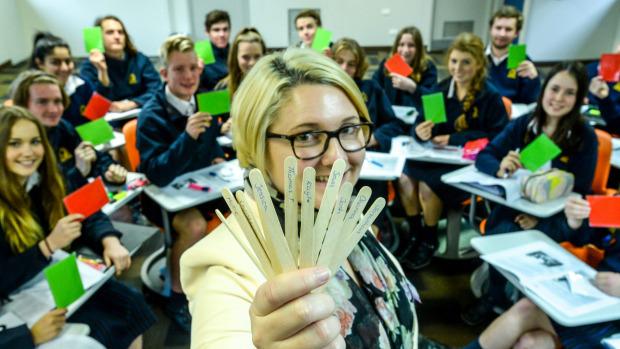
Let's call it the Hermione Granger Effect. Every classroom has at least one Hermione, the pupil who always raises their hand to prove they have the right answer. At the back of the class, kids are quickly switching off.
But some Victorian schools are banning students from putting their hands up in classrooms, as part of an experiment in changing how classes are run. Toorak College and Frankston High School are among Victorian schools taking up the no hands-up policy, along with other schools in Europe. Derinya Primary School is also considering the approach.
The theory is that the same minority of top students are raising their hands to answer teachers' questions, and are getting smarter with each response, widening the gaps between the high and low performing students. Having the smart kids answer every question can fool teachers into believing that the whole classroom are learning.
About a third of the teachers at Frankston High School are changing the old habit, by writing the students' names on sticks and pulling out names at random for answers. There is one exception to the rule. The students are allowed to raise their hand when they have a question. English and history teacher Sarah Lefebvre has been trying the policy in Year 9, 10 and 11 classes since the beginning of the year. If a student didn't know the answer, they could "phone a friend" and explore the question with their classmates.
Derinya Primary School principal Jenny Roth, who is considering taking up the strategy, said teachers were moving away from questions that require basic recall. She said they were no longer interested in students getting the right answer, but wanted to measure the students’ learning. It is about engaging all kids in the class, so they can all participate and learn, and so the teacher can quickly figure out who gets it and who doesn't.
本时文内容由奇速英语国际教育研究院原创编写,禁止复制和任何商业用途,版权所有,侵权必究!
1.When the Hermione Granger Effect happens, ______.
A all the students have the chance to answer
B the classroom are full of many Hermiones
C most of the children don’t take part in classes
D students try their best to answer questions
解析:选C。C。推理判断题。根据文章第1段第3句的 At the back of the class, kids are quickly switching off可以得知当班级中出现赫敏格兰杰效应的时候,班级里的大多数同学没法参与课堂。
2.The underlined phrase “the approach” may refer to ______.
A stopping the students putting up their hands
B changing the number of the learning students
C taking up the hands-up policy for the children
D making the children refuse to answer questions
解析:选A。A。词意推测提。根据第2段第1句的But some Victorian schools are banning students from putting their hands up in classrooms, as part of an experiment in changing how classes are run可以得知这个方法是禁止学生在课堂上举手回答问题。
3.If the top students answer teachers’ questions, the teachers will believe _____.
A the gaps are well widened
B some students get smarter
C the responses aren't right
D all the students learn well
解析:选D。D。细节理解题。根据第3段最后1句的Having the smart kids answer every question can fool teachers into believing that the whole classroom are learning可知如果顶尖的学生回答了问题,会让老师们误认为所有的学生都学会了。
4.How do the teachers at Frankston High School do when asking the students questions?
A They choose the students by chance.
B They allow them to raise their hands.
C They let them phone their classmates.
D They make them explore the questions.
解析:选A。A。推理判断题。根据第4段第1句的by writing the students' names on sticks and pulling out names at random for answers可知老师写上学生的名字随机抽取回答问题的学生。
5.What does Jenny Roth get interested in?
A Getting the right answers.
B Losing the basic recalls.
C Testing students’ learning.
D Moving the students away.
解析:选C。C。细节理解题。根据文章最后1段第2句的but wanted to measure the students’ learning可知她对老师的问题能否评估学生的学习感兴趣。